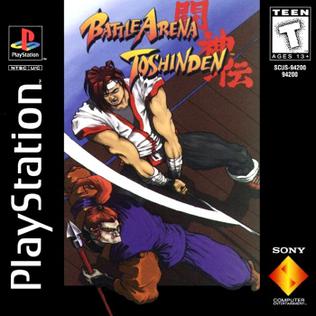
Battle Arena Toshinden, released as Toh Shin Den in Japan, is a 1995 fighting video game developed by Tamsoft and published by Takara for the PlayStation. It was one of the first fighting games, after Virtua Fighter on arcade and console, to boast polygonal characters in a 3D environment, and features a sidestep maneuver which is credited for taking the genre into "true 3D."
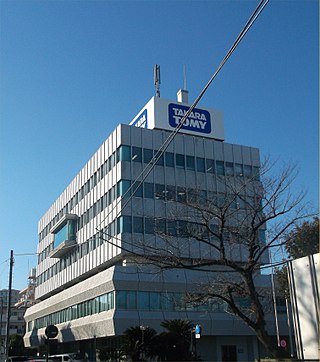
Takara Co., Ltd. was a Japanese toy company founded in 1955. In March 2006, the company merged with Tomy Company, Ltd. to form Takara Tomy. The Takara motto was「遊びは文化」("playing is culture").
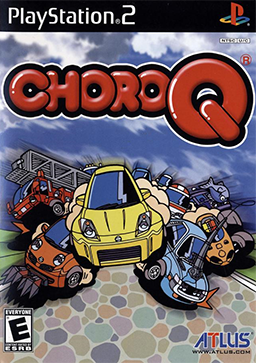
ChoroQ is a PlayStation 2 game published by Atlus in the US, Zoo Digital Publishing in PAL regions and Takara in Japan. It was developed by Barnhouse Effect. The game is marketed as a "Car-PG": a hybrid of driving and role-playing video games.
Barnhouse Effect Co., Ltd (株式会社バーンハウスエフェクト), or BHE, is a 1997 Japanese video game developer and CG production company based in Tokyo. Most of their work has been for Takara, notably Choro Q games for the PlayStation and PlayStation 2 consoles.

Penny Racers is a racing game for the Nintendo 64. It was released in Japan in 1998 and in North America and Europe in 1999. The game is part of the racing game series Choro Q based on Takara's toy line of the same name and was the first of this line to be released in North America. It had a Nintendo 64 sequel released only in Japan, Choro Q 64 2: Hachamecha Grand Prix Race. It is a customizable racer game, and has a total of 114 parts, arranged in eight categories.
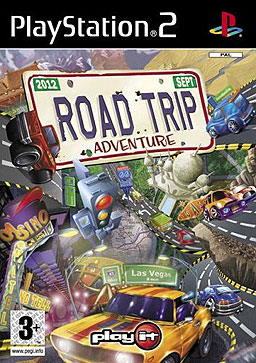
Road Trip Adventure is a 2002 racing adventure video game for the PlayStation 2, released as Choro Q HG 2 in Japan by Takara and as Road Trip in North America by Conspiracy Entertainment. In 2003 it was also released in Europe and other PAL regions by System 3 under their Play It label named Road Trip Adventure. It was developed by E-Game, a small Japanese developer.

Ridge Racer Revolution is a racing video game developed and published by Namco for the PlayStation. It is the sequel to the PlayStation version of Ridge Racer. Like the original Ridge Racer, the player races computer-controlled cars with the objective of winning a series of races, and supports Namco's NeGcon controller. Ridge Racer Revolution adds two hidden cars, and two-player support via the PlayStation Link cable, and took roughly the same time to develop as the first. The intention was to increase the depth and add features.

Tomy Company, Ltd. is a Japanese toy company. It was established in 1924 by Eiichirō Tomiyama as Tomiyama Toy Manufacturing Company (富山玩具製作所), became known for creating popular toys like the B-29 friction toy and luck-based game Pop-up Pirate. In 2006, Tomy merged with another toy manufacturer, Takara, and although the English company name remained the same, it became Takara Tomy in Asia. It has its headquarters in Katsushika, Tokyo.
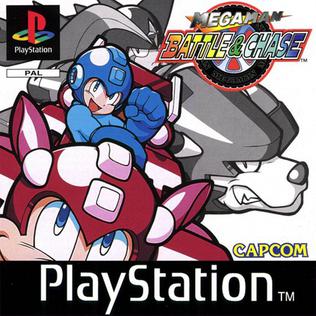
Mega Man: Battle & Chase is a racing video game based on the original Mega Man series from Capcom. The game was released in Japan on March 20, 1997 and in the PAL region on April 3, 1998 for PlayStation. Although it was not released individually in North America, Mega Man: Battle & Chase was featured on the region-exclusive Mega Man X Collection in 2006. Mega Man: Battle & Chase is a traditional racing game with an emphasis on combat. Winning a race allows the player to choose a car part from an enemy competitor as a prize. Reviews for the game have been mixed with many critics drawing comparisons to Nintendo's Mario Kart series.
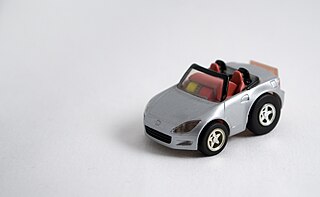
Choro-Q is a line of Japanese 3–4 cm pullback car toys produced by Takara Tomy. Known in North America as Penny Racers, they were introduced in late 1978 and have seen multiple revisions and successors since. The name comes from the Japanese term choro-choro, meaning "dash around", as well as an abbreviation of the Japanese borrowing from "cute" (kyūto) to connote their petite size.

Ridge Racer is a 1993 racing video game developed and published by Namco for arcades. It is the first installment in Namco's Ridge Racer series. It was released initially on the Namco System 22 arcade system board and ported to the PlayStation home console in 1994. Ridge Racer was notable for being the first arcade video game with 3D texture-mapped graphics, with its System 22 hardware capable of texture mapping and Gouraud shading.

The Need for Speed is a 1994 racing game developed by EA Canada, originally known as Pioneer Productions, and published by Electronic Arts for 3DO. It was later ported to other platforms with additional tracks and cars, including to MS-DOS, PlayStation, Sega Saturn, and Microsoft Windows in 1996, on which it was subtitled SE.

Road Trip: The Arcade Edition, known as Gadget Racers in Europe and Choro Q! in Japan, is a racing video game released in 2002 by Takara. It is based mainly upon Road Trip Adventure, a predecessor, however was only sold for the GameCube. Allowing this, weapons were added to a more racing perspective to make it an arcade version. It involves toy cars known in as Choro-Q or Penny Racers.

Monaco Grand Prix: Racing Simulation 2, also known simply as Monaco Grand Prix or Racing Simulation: Monaco Grand Prix, is a Formula One racing game developed and published by Ubisoft for Windows, Nintendo 64, PlayStation, and Dreamcast. It was released between 1998 and 1999. A sequel, Racing Simulation 3, was released in 2002.
Choro Q 64 2: Hachamecha Grand Prix Race is a racing game released in 1999 in Japan for the Nintendo 64. It is the sequel to Choro Q 64 and is part of the Choro Q series. The game is also compatible with the Game Boy Color game Choro Q Hyper Customable GB, using the GB Transfer Pak.
Penny Racers may refer to:

Choro Q Park is a 1998 racing video game developed by Nextech and published by Takara for the Sega Saturn. It is based on Takara's Choro Q line of pullback racer toys.

Penny Racers Party: Turbo Q Speedway is a 2008 racing video game developed by Barnhouse Effect and published by Takara Tomy for the Wii. It is part of the Choro Q video game series, which is based on Takara's toy line of the same name.

Choro Q Wonderful! (チョロQワンダフォー!) is a 1999 role-playing and racing video game for the PlayStation, developed by E-game and published by Takara. It is the successor to the Tamsoft-developed Choro Q 3 and hence the third sequel to Penny Racers (1996); the "Wonderful" name in its title, in Japanese pronunciation, is a pun on "four". An English-language fan translation was released in 2023.

















